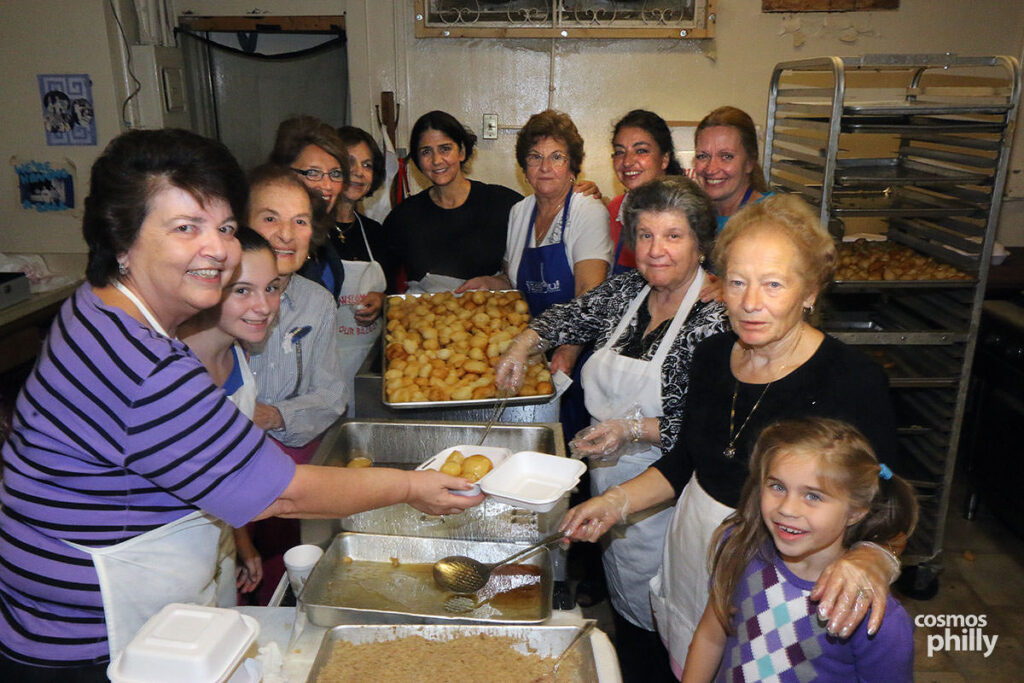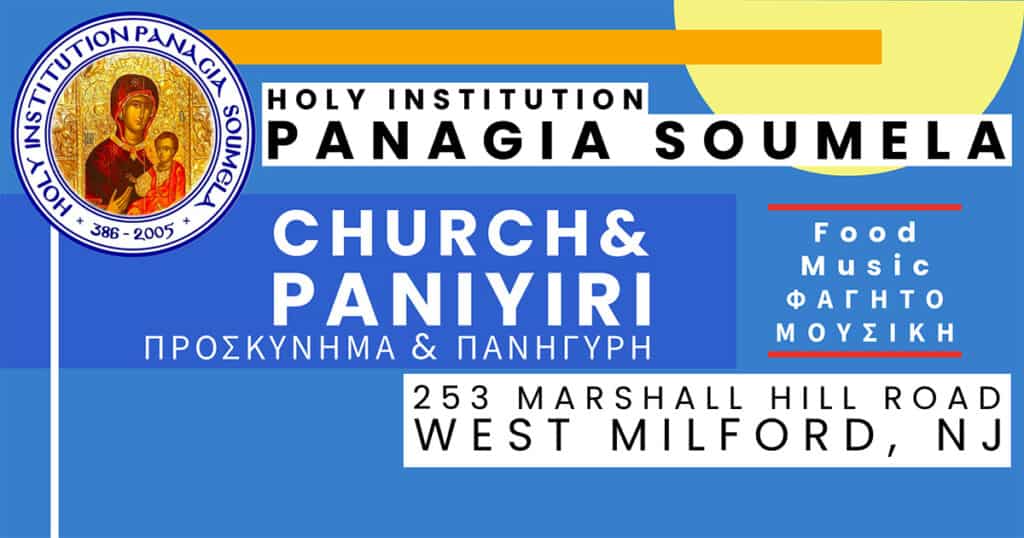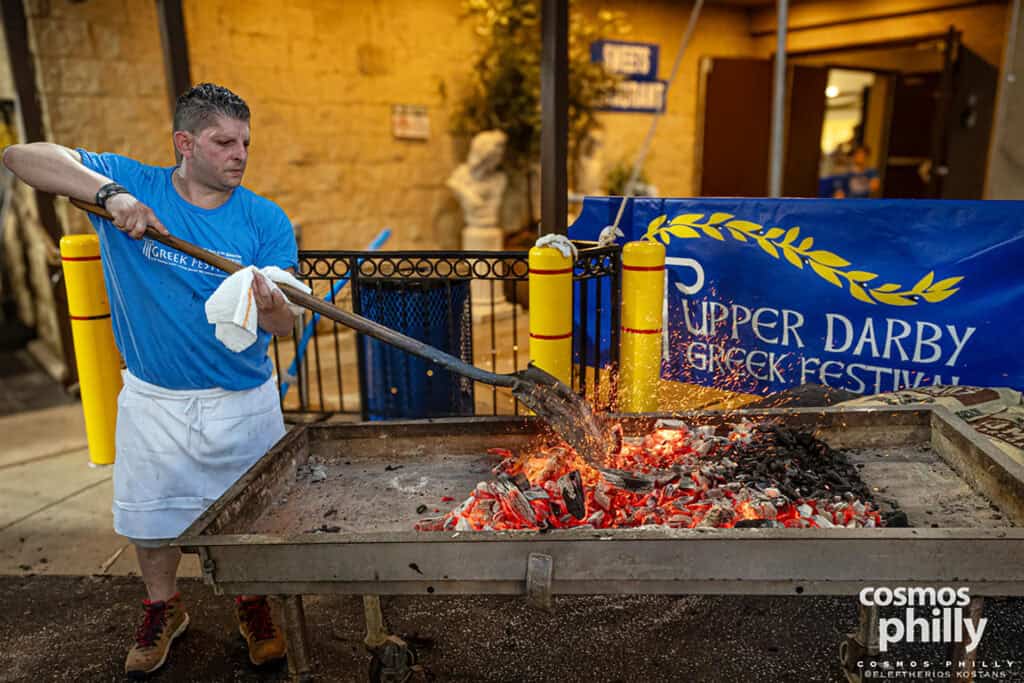Reading, PA – This past weekend, the folks at Sts. Constantine and Helen Greek Orthodox church hosted their annual Greek Food Bazaar. It had all the sights, sounds and flavors we’ve come to know and love about Greek culture and left us longing for Greece. But more importantly, we came away with a great sense of pride and belief about this community’s future.
As we entered the main hall on Saturday night, Greek music welcomed us, while the aromas of a Greek kitchen filled the air. Beyond the tables of visitors an elevated stage with a spotlight sat the MC/DJ. “Take our church tour and experience our culture and Orthodox faith”, yelled Sasha, the veteran DJ. Sasha has been the MC for this affair for 40 years now. Dressed in traditional Greek folk attire and waving his arms, his Polka like personality got Greek food lovers up to dance even while enjoying diner. In between playing Greek music, he made the occasional invitation and announcement.
Like a busy Greek Agora, we followed the flow of trafficking visitors, that made their way through the various shops that line the hallway. Each turn inside the Sts. Constantine and Helen community center left you in a room full of spirited parishioners ready and willing to serve. A heritage room, jewelry store, coffee house and taverna were all part of the walking neighborhood tour.
We made our way into the taverna for an ala carte meal, where the lights were turned down low. There, we sampled the Greek baked chicken, pastitsio, and grape leaves. Large portions filled our plates as we sat with locals and mingled. Fishnets covered the walls and broken Greek could be overheard, adding to the atmosphere of a Greek fishing village.
Across the hall, we got our caffeine fix in at the local coffee house, where a piping hot brew of traditional Greek coffee was being served. Harry Dialetcos dressed in a Greek fishermans cap carefully assembled the noted elixirs one at a time. A patient, but long line formed by the eagerly awaiting customers. “My wife and I have been part of this church for a long time,”said Dialectos. “It’s a love of church and fellowship, that’s why I’m here”.
At the end of the hall, another long line formed for the famed loukoumades. “ Here we make them perfect. It’s a balance of crusty shell and soft inside. You really must have to understand how to handle the gluten”, said Costa, another Hellene. Behind the counter, a kitchen full of volunteers lined up and shared the duties. These were the church’s heart and soul, the senior parishioners. Mostly made up of immigrant and 1st generation Greek woman, it was obvious that they wielded a love of their community. “I’ve been here every day for a week now, we don’t take any time off”, said one woman as she smiled with pride. Decked out in white aprons the ladies smiled as they bragged about their church festival and their homemade Greek food. I was reminded of my mother’s kitchen, which brought on a sense of warmth and comfort. Although it was a church kitchen it was their home. Just like any Greek mom, they offered to feed me and the videographer. Naturally, we had to sample the well known sweet. “Loukoumades have been around for thousands of years, their ancient, “said Costa the Greek. “The traditional honey balls that you’re eating today evolved around 500 years ago in Greece”, he added.
As we looped back to the main hall, we stopped to examine a historic display of images, books and church items in the Heritage room. Black and white images of three churches, covering the 100 years of history, and a timeline wrapped around the walls of this room. Most churches I’ve been to, do not have such a well documented history. This one chronicled the Greeks of Reading Pennsylvania in full detail.
The first settlers began arriving around 1907 and built their first church in 1913 in downtown Reading. In 1970, their current and third location, just down the road outside the city limits, has now blossomed with some 500 families, making it the largest and arguably the oldest Greek Orthodox church in the area. The history on display was produced by unofficial church historian Gust Kraras. Ninety-five years young and still going strong, Kraras told of his parishes history and where the Greeks came from more than three generations ago. Well known in Reading and a dual member of two parishes, Kraras had recently produced a leather bound history book of this community which was on display. “Most families came from Mytilini and Kos, following a journey, in the footsteps of their relatives and settling here, “ said Kraras.
As we came full circle into the main dining room, Greek dancers had gathered to perform various dances from Greece. The next generation of young Greek-Americans, part of the GOYA (Greek Orthodox Youth Association) were introduced by Sasha the DJ. Whistling fans and parents snapped up the photo ops. In the background, grandparents and grandchildren embraced as they clapped together, uniting the generations.
As I looked on at the dancers and the generations of parishioners, a confident feeling came over me. I reflected on the fact, that last year this community celebrated its one hundredth year as a Greek Orthodox community in America. They managed to preserve their community, culture, language and faith for four generations. I knew then, that these Greeks of Reading will be around another one hundred years.



































